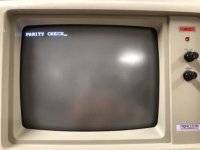Remember to scan and disinfect all the floppies you ever inserted into this machine, and other machines you used these floppies in. The Parity Boot virus will stick to you like glue, trust me... I still found infected floppies decades after having the first Parity Boot infection.
For a quick test: Boot the machine from a known clean and write protected DOS boot floppy. You shouldn't receive the PARITY CHECK message anymore. You could even take a look at the boot sector of the hard disk with Norton Disk Editor while working from a clean boot floppy and see the virus itself. Probably won't work when the computer is booted from an infected medium - if I remember correctly, the virus will hide any changes to the bootsector and just deliver an intact original boot sector when it is active.

